Disastrous Effect of Price Floor on Australian Wool Industry
VerifiedAdded on 2023/06/04
|7
|1813
|312
AI Summary
The paper evaluates the imposed price floor on Australian wool industry and discusses the disastrous effect of implementing a price floor. The policy of price floor though ensures a high price for producers of wool, there are other consequences of the policy as well that distorts the market. The side effect of price floor exceeds that of its welfare consequences. The paper provides three reasons in support of free market environment in the wool industry. The reasons are price floor and market distortion, supply and demand crisis in the wool industry, and political fallacy of the reserve price scheme.
Contribute Materials
Your contribution can guide someone’s learning journey. Share your
documents today.
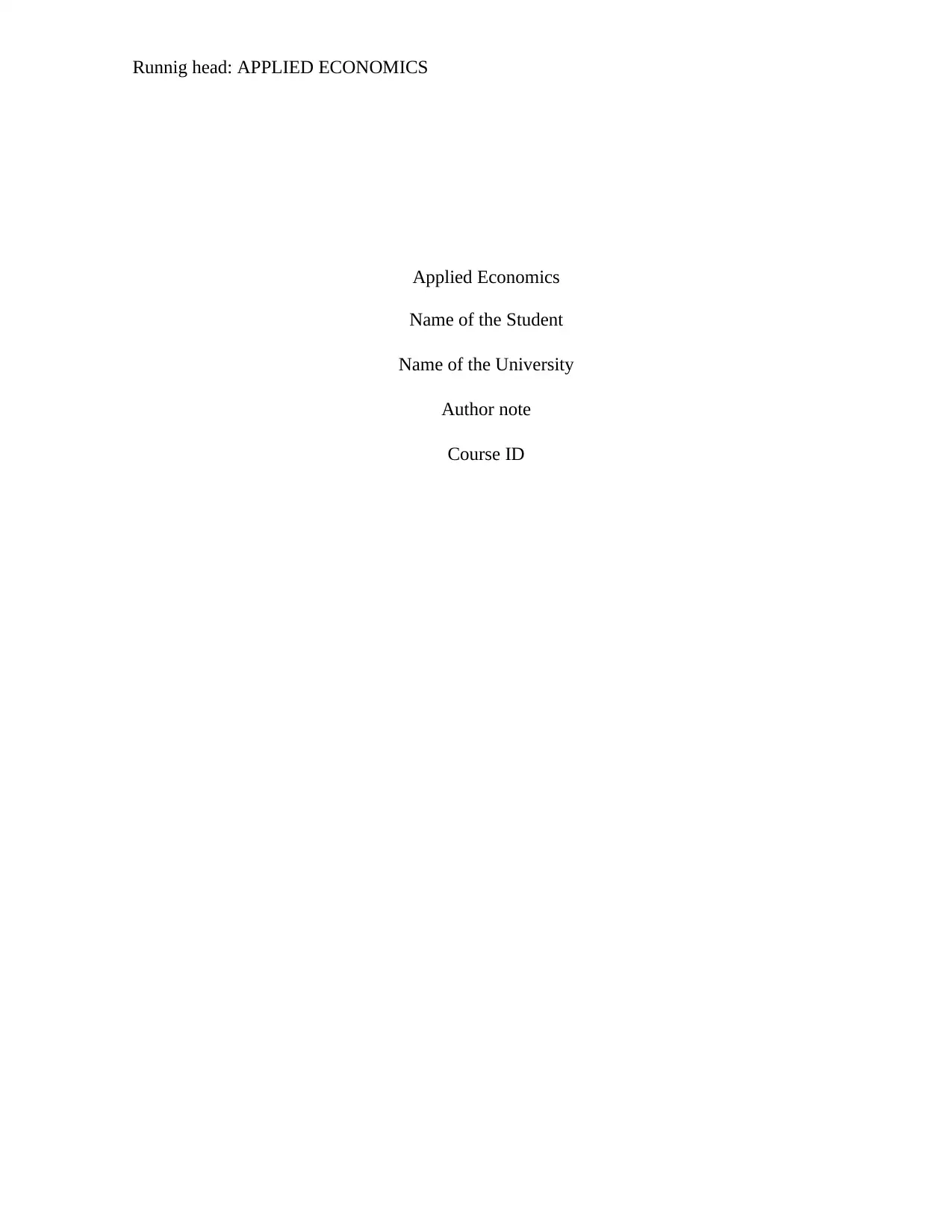
Runnig head: APPLIED ECONOMICS
Applied Economics
Name of the Student
Name of the University
Author note
Course ID
Applied Economics
Name of the Student
Name of the University
Author note
Course ID
Secure Best Marks with AI Grader
Need help grading? Try our AI Grader for instant feedback on your assignments.
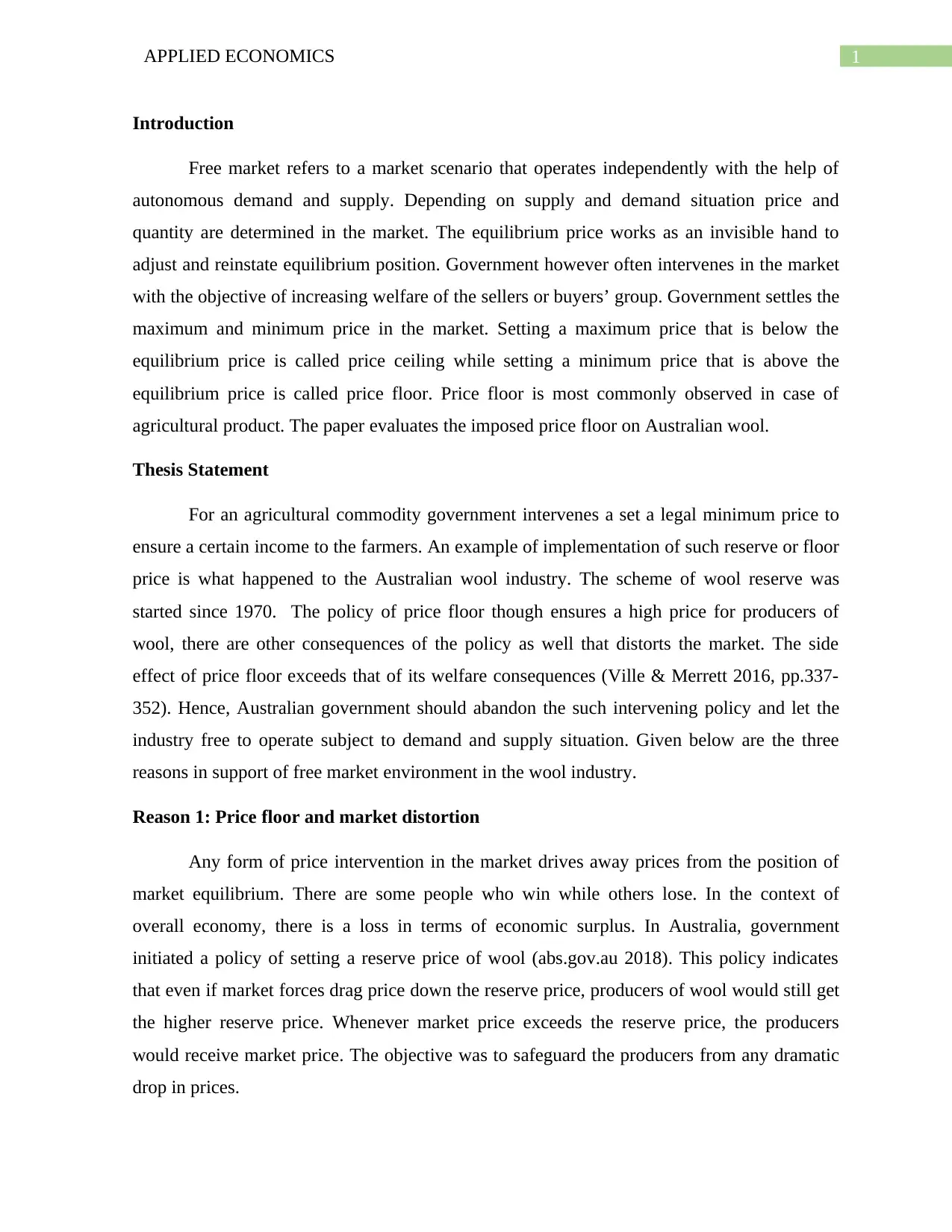
1APPLIED ECONOMICS
Introduction
Free market refers to a market scenario that operates independently with the help of
autonomous demand and supply. Depending on supply and demand situation price and
quantity are determined in the market. The equilibrium price works as an invisible hand to
adjust and reinstate equilibrium position. Government however often intervenes in the market
with the objective of increasing welfare of the sellers or buyers’ group. Government settles the
maximum and minimum price in the market. Setting a maximum price that is below the
equilibrium price is called price ceiling while setting a minimum price that is above the
equilibrium price is called price floor. Price floor is most commonly observed in case of
agricultural product. The paper evaluates the imposed price floor on Australian wool.
Thesis Statement
For an agricultural commodity government intervenes a set a legal minimum price to
ensure a certain income to the farmers. An example of implementation of such reserve or floor
price is what happened to the Australian wool industry. The scheme of wool reserve was
started since 1970. The policy of price floor though ensures a high price for producers of
wool, there are other consequences of the policy as well that distorts the market. The side
effect of price floor exceeds that of its welfare consequences (Ville & Merrett 2016, pp.337-
352). Hence, Australian government should abandon the such intervening policy and let the
industry free to operate subject to demand and supply situation. Given below are the three
reasons in support of free market environment in the wool industry.
Reason 1: Price floor and market distortion
Any form of price intervention in the market drives away prices from the position of
market equilibrium. There are some people who win while others lose. In the context of
overall economy, there is a loss in terms of economic surplus. In Australia, government
initiated a policy of setting a reserve price of wool (abs.gov.au 2018). This policy indicates
that even if market forces drag price down the reserve price, producers of wool would still get
the higher reserve price. Whenever market price exceeds the reserve price, the producers
would receive market price. The objective was to safeguard the producers from any dramatic
drop in prices.
Introduction
Free market refers to a market scenario that operates independently with the help of
autonomous demand and supply. Depending on supply and demand situation price and
quantity are determined in the market. The equilibrium price works as an invisible hand to
adjust and reinstate equilibrium position. Government however often intervenes in the market
with the objective of increasing welfare of the sellers or buyers’ group. Government settles the
maximum and minimum price in the market. Setting a maximum price that is below the
equilibrium price is called price ceiling while setting a minimum price that is above the
equilibrium price is called price floor. Price floor is most commonly observed in case of
agricultural product. The paper evaluates the imposed price floor on Australian wool.
Thesis Statement
For an agricultural commodity government intervenes a set a legal minimum price to
ensure a certain income to the farmers. An example of implementation of such reserve or floor
price is what happened to the Australian wool industry. The scheme of wool reserve was
started since 1970. The policy of price floor though ensures a high price for producers of
wool, there are other consequences of the policy as well that distorts the market. The side
effect of price floor exceeds that of its welfare consequences (Ville & Merrett 2016, pp.337-
352). Hence, Australian government should abandon the such intervening policy and let the
industry free to operate subject to demand and supply situation. Given below are the three
reasons in support of free market environment in the wool industry.
Reason 1: Price floor and market distortion
Any form of price intervention in the market drives away prices from the position of
market equilibrium. There are some people who win while others lose. In the context of
overall economy, there is a loss in terms of economic surplus. In Australia, government
initiated a policy of setting a reserve price of wool (abs.gov.au 2018). This policy indicates
that even if market forces drag price down the reserve price, producers of wool would still get
the higher reserve price. Whenever market price exceeds the reserve price, the producers
would receive market price. The objective was to safeguard the producers from any dramatic
drop in prices.
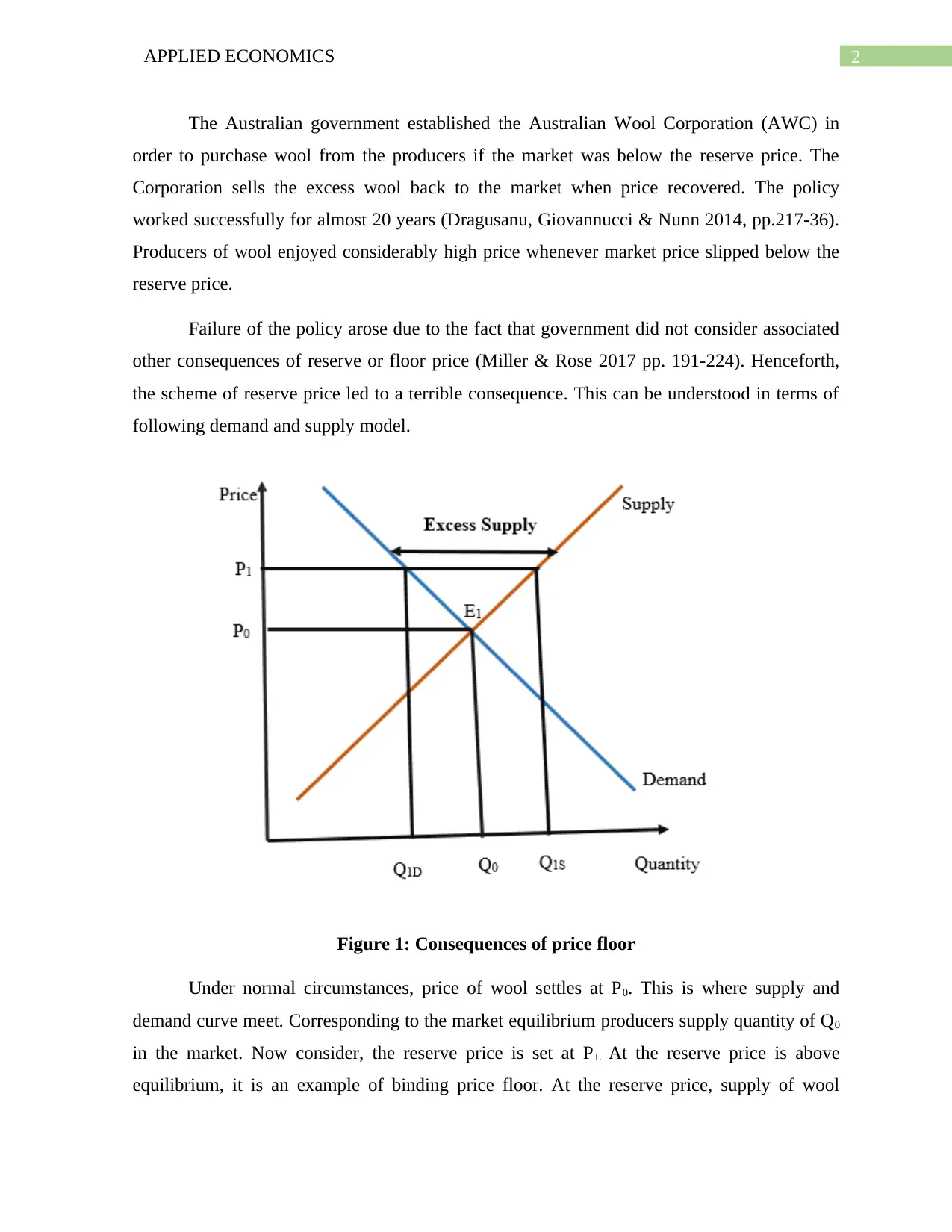
2APPLIED ECONOMICS
The Australian government established the Australian Wool Corporation (AWC) in
order to purchase wool from the producers if the market was below the reserve price. The
Corporation sells the excess wool back to the market when price recovered. The policy
worked successfully for almost 20 years (Dragusanu, Giovannucci & Nunn 2014, pp.217-36).
Producers of wool enjoyed considerably high price whenever market price slipped below the
reserve price.
Failure of the policy arose due to the fact that government did not consider associated
other consequences of reserve or floor price (Miller & Rose 2017 pp. 191-224). Henceforth,
the scheme of reserve price led to a terrible consequence. This can be understood in terms of
following demand and supply model.
Figure 1: Consequences of price floor
Under normal circumstances, price of wool settles at P0. This is where supply and
demand curve meet. Corresponding to the market equilibrium producers supply quantity of Q0
in the market. Now consider, the reserve price is set at P1. At the reserve price is above
equilibrium, it is an example of binding price floor. At the reserve price, supply of wool
The Australian government established the Australian Wool Corporation (AWC) in
order to purchase wool from the producers if the market was below the reserve price. The
Corporation sells the excess wool back to the market when price recovered. The policy
worked successfully for almost 20 years (Dragusanu, Giovannucci & Nunn 2014, pp.217-36).
Producers of wool enjoyed considerably high price whenever market price slipped below the
reserve price.
Failure of the policy arose due to the fact that government did not consider associated
other consequences of reserve or floor price (Miller & Rose 2017 pp. 191-224). Henceforth,
the scheme of reserve price led to a terrible consequence. This can be understood in terms of
following demand and supply model.
Figure 1: Consequences of price floor
Under normal circumstances, price of wool settles at P0. This is where supply and
demand curve meet. Corresponding to the market equilibrium producers supply quantity of Q0
in the market. Now consider, the reserve price is set at P1. At the reserve price is above
equilibrium, it is an example of binding price floor. At the reserve price, supply of wool
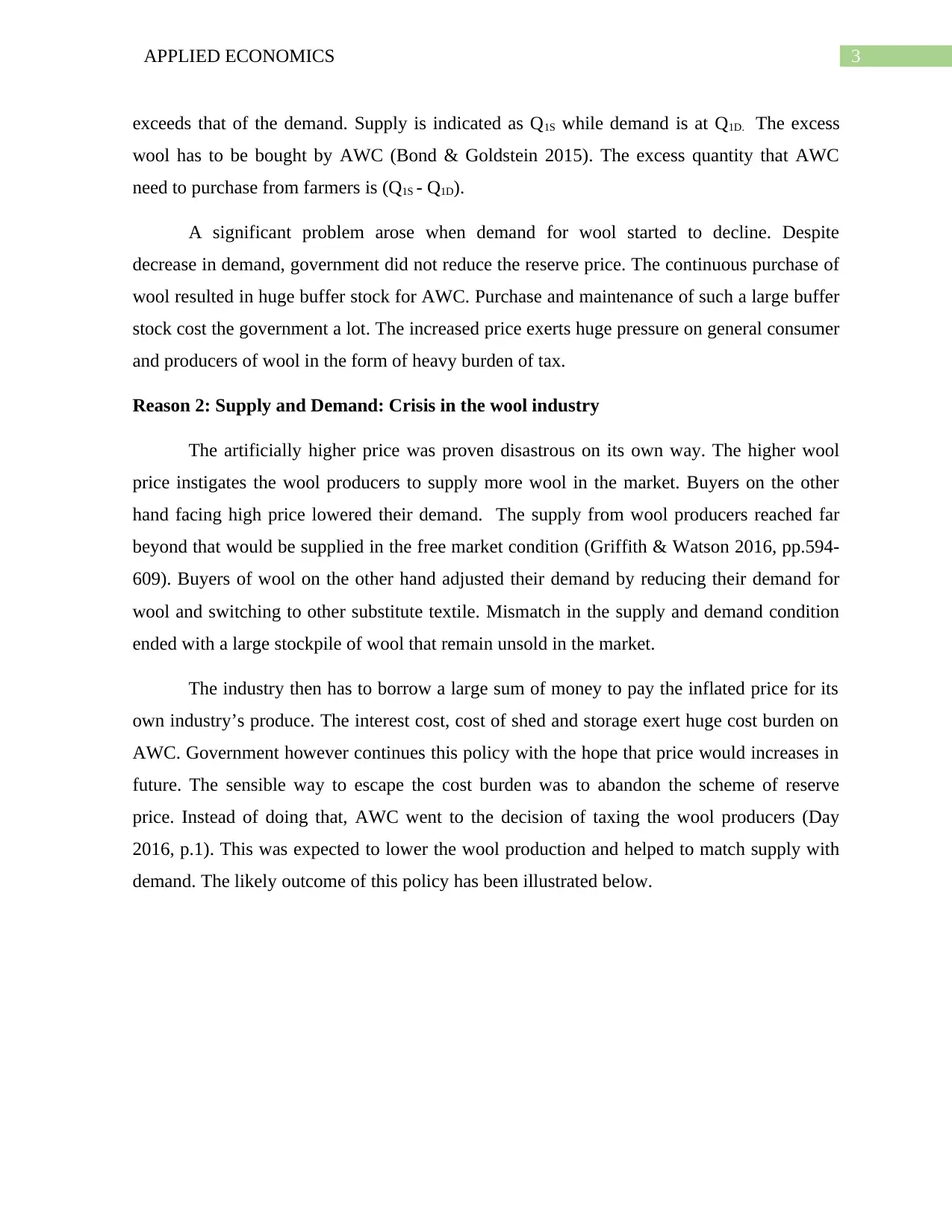
3APPLIED ECONOMICS
exceeds that of the demand. Supply is indicated as Q1S while demand is at Q1D. The excess
wool has to be bought by AWC (Bond & Goldstein 2015). The excess quantity that AWC
need to purchase from farmers is (Q1S - Q1D).
A significant problem arose when demand for wool started to decline. Despite
decrease in demand, government did not reduce the reserve price. The continuous purchase of
wool resulted in huge buffer stock for AWC. Purchase and maintenance of such a large buffer
stock cost the government a lot. The increased price exerts huge pressure on general consumer
and producers of wool in the form of heavy burden of tax.
Reason 2: Supply and Demand: Crisis in the wool industry
The artificially higher price was proven disastrous on its own way. The higher wool
price instigates the wool producers to supply more wool in the market. Buyers on the other
hand facing high price lowered their demand. The supply from wool producers reached far
beyond that would be supplied in the free market condition (Griffith & Watson 2016, pp.594-
609). Buyers of wool on the other hand adjusted their demand by reducing their demand for
wool and switching to other substitute textile. Mismatch in the supply and demand condition
ended with a large stockpile of wool that remain unsold in the market.
The industry then has to borrow a large sum of money to pay the inflated price for its
own industry’s produce. The interest cost, cost of shed and storage exert huge cost burden on
AWC. Government however continues this policy with the hope that price would increases in
future. The sensible way to escape the cost burden was to abandon the scheme of reserve
price. Instead of doing that, AWC went to the decision of taxing the wool producers (Day
2016, p.1). This was expected to lower the wool production and helped to match supply with
demand. The likely outcome of this policy has been illustrated below.
exceeds that of the demand. Supply is indicated as Q1S while demand is at Q1D. The excess
wool has to be bought by AWC (Bond & Goldstein 2015). The excess quantity that AWC
need to purchase from farmers is (Q1S - Q1D).
A significant problem arose when demand for wool started to decline. Despite
decrease in demand, government did not reduce the reserve price. The continuous purchase of
wool resulted in huge buffer stock for AWC. Purchase and maintenance of such a large buffer
stock cost the government a lot. The increased price exerts huge pressure on general consumer
and producers of wool in the form of heavy burden of tax.
Reason 2: Supply and Demand: Crisis in the wool industry
The artificially higher price was proven disastrous on its own way. The higher wool
price instigates the wool producers to supply more wool in the market. Buyers on the other
hand facing high price lowered their demand. The supply from wool producers reached far
beyond that would be supplied in the free market condition (Griffith & Watson 2016, pp.594-
609). Buyers of wool on the other hand adjusted their demand by reducing their demand for
wool and switching to other substitute textile. Mismatch in the supply and demand condition
ended with a large stockpile of wool that remain unsold in the market.
The industry then has to borrow a large sum of money to pay the inflated price for its
own industry’s produce. The interest cost, cost of shed and storage exert huge cost burden on
AWC. Government however continues this policy with the hope that price would increases in
future. The sensible way to escape the cost burden was to abandon the scheme of reserve
price. Instead of doing that, AWC went to the decision of taxing the wool producers (Day
2016, p.1). This was expected to lower the wool production and helped to match supply with
demand. The likely outcome of this policy has been illustrated below.
Secure Best Marks with AI Grader
Need help grading? Try our AI Grader for instant feedback on your assignments.
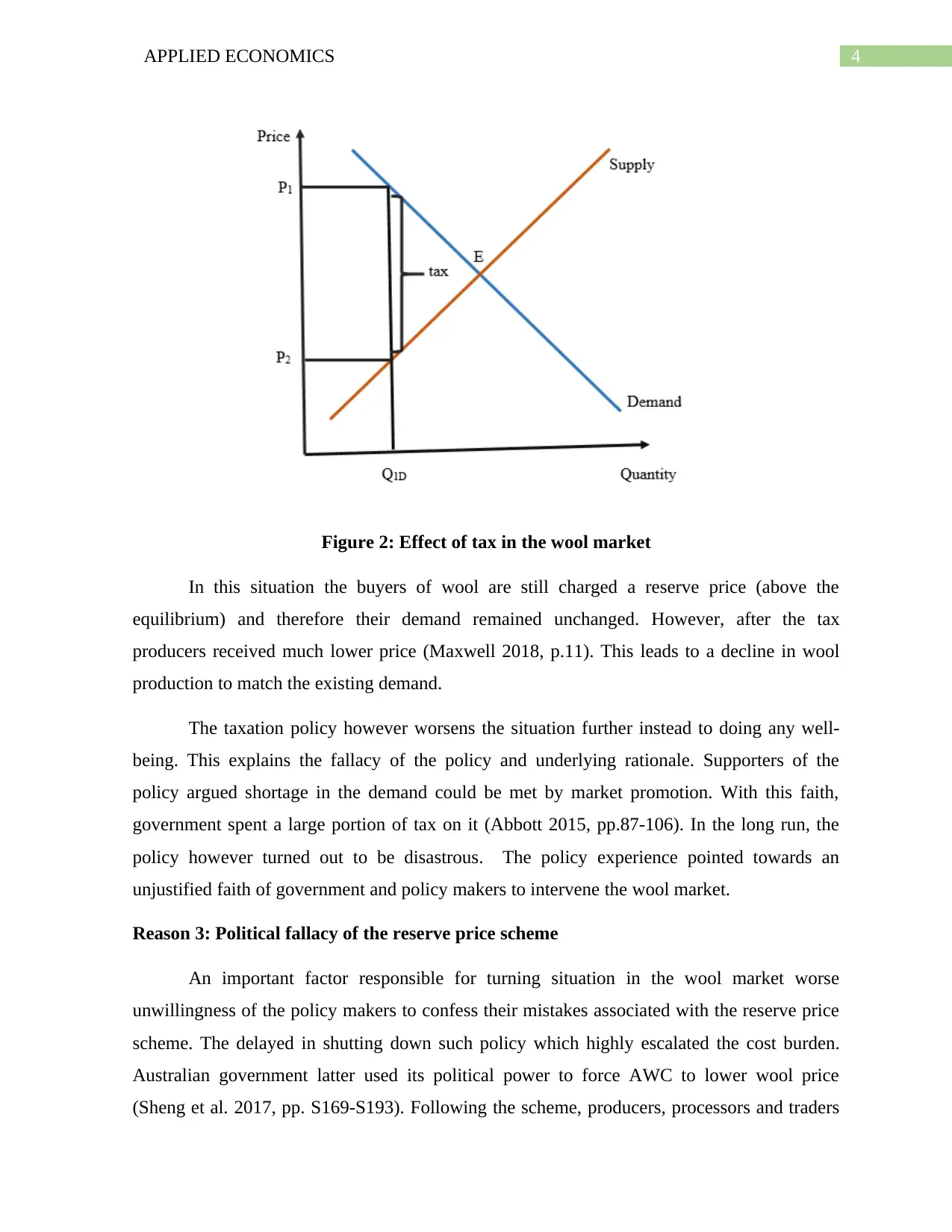
4APPLIED ECONOMICS
Figure 2: Effect of tax in the wool market
In this situation the buyers of wool are still charged a reserve price (above the
equilibrium) and therefore their demand remained unchanged. However, after the tax
producers received much lower price (Maxwell 2018, p.11). This leads to a decline in wool
production to match the existing demand.
The taxation policy however worsens the situation further instead to doing any well-
being. This explains the fallacy of the policy and underlying rationale. Supporters of the
policy argued shortage in the demand could be met by market promotion. With this faith,
government spent a large portion of tax on it (Abbott 2015, pp.87-106). In the long run, the
policy however turned out to be disastrous. The policy experience pointed towards an
unjustified faith of government and policy makers to intervene the wool market.
Reason 3: Political fallacy of the reserve price scheme
An important factor responsible for turning situation in the wool market worse
unwillingness of the policy makers to confess their mistakes associated with the reserve price
scheme. The delayed in shutting down such policy which highly escalated the cost burden.
Australian government latter used its political power to force AWC to lower wool price
(Sheng et al. 2017, pp. S169-S193). Following the scheme, producers, processors and traders
Figure 2: Effect of tax in the wool market
In this situation the buyers of wool are still charged a reserve price (above the
equilibrium) and therefore their demand remained unchanged. However, after the tax
producers received much lower price (Maxwell 2018, p.11). This leads to a decline in wool
production to match the existing demand.
The taxation policy however worsens the situation further instead to doing any well-
being. This explains the fallacy of the policy and underlying rationale. Supporters of the
policy argued shortage in the demand could be met by market promotion. With this faith,
government spent a large portion of tax on it (Abbott 2015, pp.87-106). In the long run, the
policy however turned out to be disastrous. The policy experience pointed towards an
unjustified faith of government and policy makers to intervene the wool market.
Reason 3: Political fallacy of the reserve price scheme
An important factor responsible for turning situation in the wool market worse
unwillingness of the policy makers to confess their mistakes associated with the reserve price
scheme. The delayed in shutting down such policy which highly escalated the cost burden.
Australian government latter used its political power to force AWC to lower wool price
(Sheng et al. 2017, pp. S169-S193). Following the scheme, producers, processors and traders
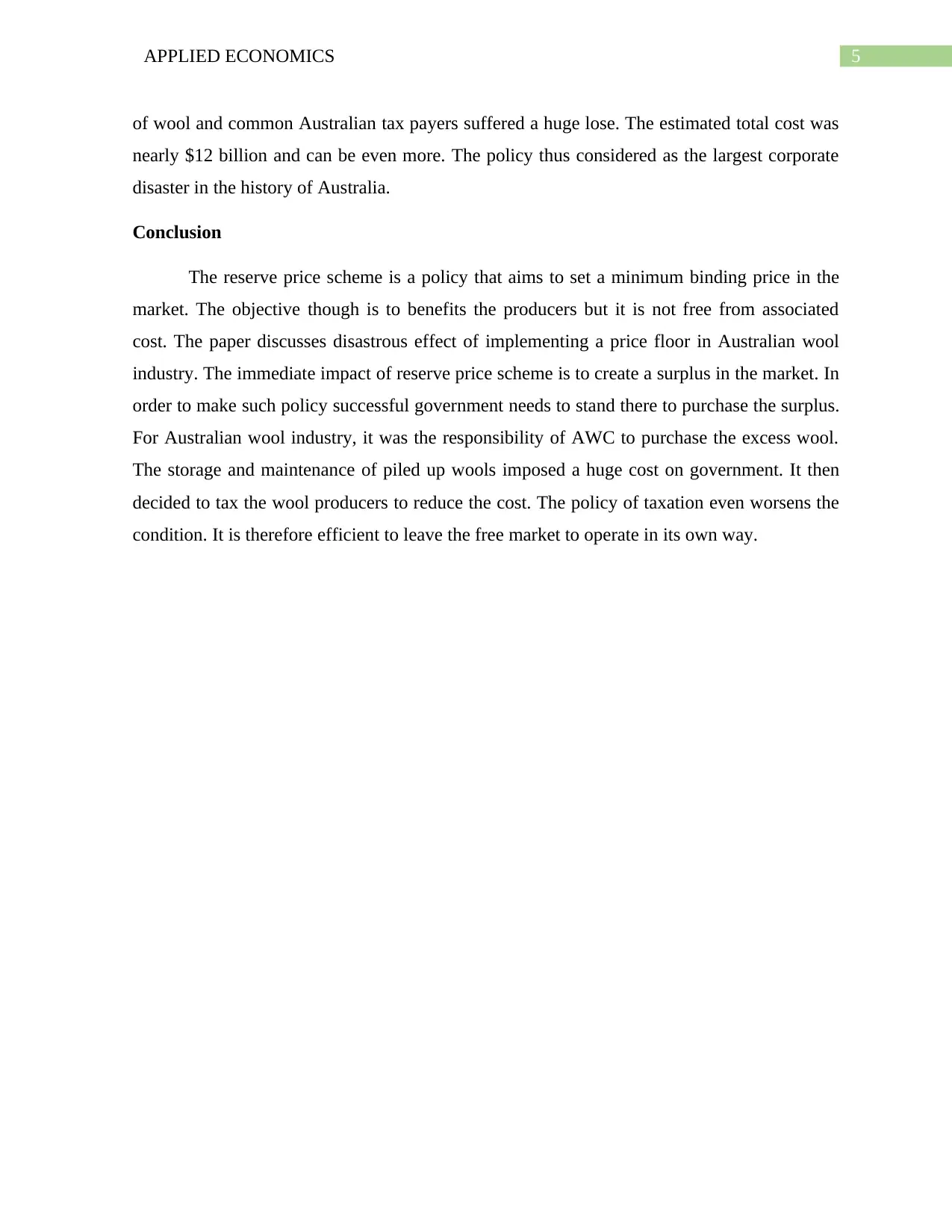
5APPLIED ECONOMICS
of wool and common Australian tax payers suffered a huge lose. The estimated total cost was
nearly $12 billion and can be even more. The policy thus considered as the largest corporate
disaster in the history of Australia.
Conclusion
The reserve price scheme is a policy that aims to set a minimum binding price in the
market. The objective though is to benefits the producers but it is not free from associated
cost. The paper discusses disastrous effect of implementing a price floor in Australian wool
industry. The immediate impact of reserve price scheme is to create a surplus in the market. In
order to make such policy successful government needs to stand there to purchase the surplus.
For Australian wool industry, it was the responsibility of AWC to purchase the excess wool.
The storage and maintenance of piled up wools imposed a huge cost on government. It then
decided to tax the wool producers to reduce the cost. The policy of taxation even worsens the
condition. It is therefore efficient to leave the free market to operate in its own way.
of wool and common Australian tax payers suffered a huge lose. The estimated total cost was
nearly $12 billion and can be even more. The policy thus considered as the largest corporate
disaster in the history of Australia.
Conclusion
The reserve price scheme is a policy that aims to set a minimum binding price in the
market. The objective though is to benefits the producers but it is not free from associated
cost. The paper discusses disastrous effect of implementing a price floor in Australian wool
industry. The immediate impact of reserve price scheme is to create a surplus in the market. In
order to make such policy successful government needs to stand there to purchase the surplus.
For Australian wool industry, it was the responsibility of AWC to purchase the excess wool.
The storage and maintenance of piled up wools imposed a huge cost on government. It then
decided to tax the wool producers to reduce the cost. The policy of taxation even worsens the
condition. It is therefore efficient to leave the free market to operate in its own way.
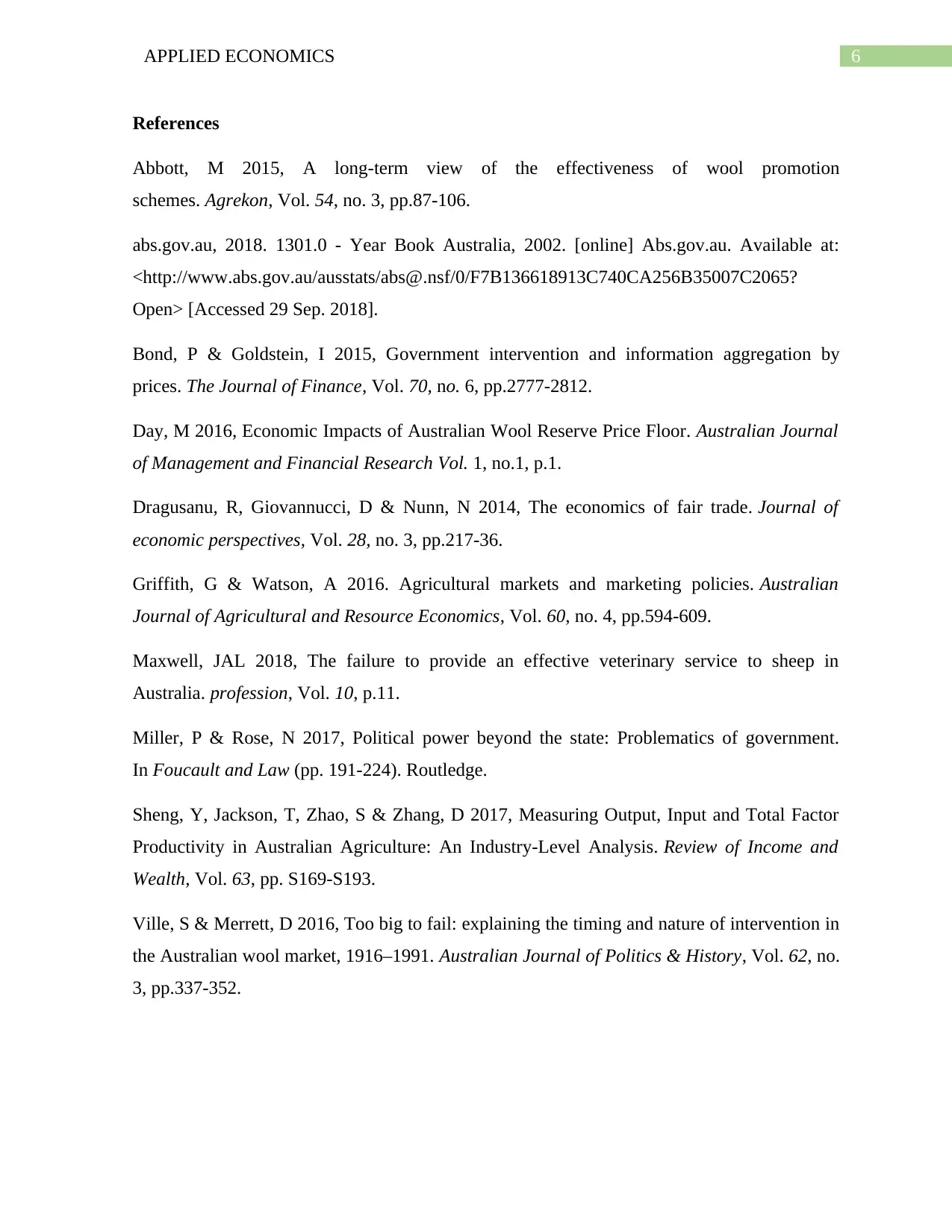
6APPLIED ECONOMICS
References
Abbott, M 2015, A long-term view of the effectiveness of wool promotion
schemes. Agrekon, Vol. 54, no. 3, pp.87-106.
abs.gov.au, 2018. 1301.0 - Year Book Australia, 2002. [online] Abs.gov.au. Available at:
<http://www.abs.gov.au/ausstats/abs@.nsf/0/F7B136618913C740CA256B35007C2065?
Open> [Accessed 29 Sep. 2018].
Bond, P & Goldstein, I 2015, Government intervention and information aggregation by
prices. The Journal of Finance, Vol. 70, no. 6, pp.2777-2812.
Day, M 2016, Economic Impacts of Australian Wool Reserve Price Floor. Australian Journal
of Management and Financial Research Vol. 1, no.1, p.1.
Dragusanu, R, Giovannucci, D & Nunn, N 2014, The economics of fair trade. Journal of
economic perspectives, Vol. 28, no. 3, pp.217-36.
Griffith, G & Watson, A 2016. Agricultural markets and marketing policies. Australian
Journal of Agricultural and Resource Economics, Vol. 60, no. 4, pp.594-609.
Maxwell, JAL 2018, The failure to provide an effective veterinary service to sheep in
Australia. profession, Vol. 10, p.11.
Miller, P & Rose, N 2017, Political power beyond the state: Problematics of government.
In Foucault and Law (pp. 191-224). Routledge.
Sheng, Y, Jackson, T, Zhao, S & Zhang, D 2017, Measuring Output, Input and Total Factor
Productivity in Australian Agriculture: An Industry‐Level Analysis. Review of Income and
Wealth, Vol. 63, pp. S169-S193.
Ville, S & Merrett, D 2016, Too big to fail: explaining the timing and nature of intervention in
the Australian wool market, 1916–1991. Australian Journal of Politics & History, Vol. 62, no.
3, pp.337-352.
References
Abbott, M 2015, A long-term view of the effectiveness of wool promotion
schemes. Agrekon, Vol. 54, no. 3, pp.87-106.
abs.gov.au, 2018. 1301.0 - Year Book Australia, 2002. [online] Abs.gov.au. Available at:
<http://www.abs.gov.au/ausstats/abs@.nsf/0/F7B136618913C740CA256B35007C2065?
Open> [Accessed 29 Sep. 2018].
Bond, P & Goldstein, I 2015, Government intervention and information aggregation by
prices. The Journal of Finance, Vol. 70, no. 6, pp.2777-2812.
Day, M 2016, Economic Impacts of Australian Wool Reserve Price Floor. Australian Journal
of Management and Financial Research Vol. 1, no.1, p.1.
Dragusanu, R, Giovannucci, D & Nunn, N 2014, The economics of fair trade. Journal of
economic perspectives, Vol. 28, no. 3, pp.217-36.
Griffith, G & Watson, A 2016. Agricultural markets and marketing policies. Australian
Journal of Agricultural and Resource Economics, Vol. 60, no. 4, pp.594-609.
Maxwell, JAL 2018, The failure to provide an effective veterinary service to sheep in
Australia. profession, Vol. 10, p.11.
Miller, P & Rose, N 2017, Political power beyond the state: Problematics of government.
In Foucault and Law (pp. 191-224). Routledge.
Sheng, Y, Jackson, T, Zhao, S & Zhang, D 2017, Measuring Output, Input and Total Factor
Productivity in Australian Agriculture: An Industry‐Level Analysis. Review of Income and
Wealth, Vol. 63, pp. S169-S193.
Ville, S & Merrett, D 2016, Too big to fail: explaining the timing and nature of intervention in
the Australian wool market, 1916–1991. Australian Journal of Politics & History, Vol. 62, no.
3, pp.337-352.
1 out of 7
Related Documents
Your All-in-One AI-Powered Toolkit for Academic Success.
+13062052269
info@desklib.com
Available 24*7 on WhatsApp / Email
![[object Object]](/_next/static/media/star-bottom.7253800d.svg)
Unlock your academic potential
© 2024 | Zucol Services PVT LTD | All rights reserved.





